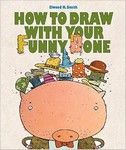Through the Looking Glass Children's Book Reviews
How to draw with your funny bone
Nonfiction Art Book
For ages 6 to 8
Creative Editions, 2015 ISBN: 978-1568462431
These days Elwood H. Smith is a trained professional artist, but once upon a time he was a kid who liked to draw funny pictures for his friends. He believes that every kid has a drawing funny bone, and all you have to do is to find it is to grab something to draw with, and you are ready to begin a wonderful artistic adventure.
Of course, before you can really tap into your creative funny bone you do have to do “a little studying,” and Elwood begins by showing us two pictures of a pig. One is a vintage illustration and the other is a photo. Then Ellwood shows us how he draws his own pig, a funny bone pig. His pig does not look exactly like a real pig, but we can tell what it is straight away. Instead of drawing exactly what he sees, Elwood does what funny-bone artists do; he sees something and then changes it. He also makes “a lot of stuff up.”
Next, Elwood goes on to talk about drawing cars. If you look at how little children draw cars you will see that their creations don’t really look like real cars, they are, in fact, funny bone cars. Apparently, little kids “naturally use their funny bones.” So, how does one make a funny bone car? All you have to do is to draw a general car shape and then add “stuff.”
This sounds easy enough, but how do you begin? Fear not, because next Elwood shows you just how to do this. He shows his readers how to take basic shapes – circles, squares, and triangles – and turn them into a pig, a dog and a bird. Then he goes on to draw all kinds of great things using basic shapes. In Part 2 of his lesson Elwood shows us how to draw these same three shapes in 3D so that we can create characters and things that don’t look flat on the page.
Elwood then goes on to talk about technique, and he shows us how to draw monsters, food, furniture, dogs, and letters. He even talks about drawing faces, and invites his reader to draw his or her own face, right there on a page provided. As a final challenge he asks his readers to draw a kid, in “your own way.”
Children who are eager to become young artists, but who are intimidated by the prospect, are going to enjoy exploring this engaging and amusing book. The author encourages his audience to try things out and to explore, and young artists will come to appreciate that when you use your funny bone to draw, anything can happen.



